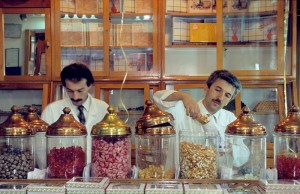Game Poem 20: Monsieur Praslin’s Candy Shoppe
Kind old Monsieur Praslin is the proprietor of the greatest candy shop in town. This is not only on account of his superlative sweets, but because he is given to distributing free sweets to children who come to him with tales of what good little tykes they have been. That, and sometimes he is not as sharp-eyed as he used to be, and is not as quick to notice if little hands grab an extra handful or two! However, the finest and most coveted confectionery of all, the famous Praslin’s Praline, it sits upon the top shelf, and can only be obtained by the youngster who proves to be the most upstanding and precious among his or her peers – or the one who shows the most moxie and swipes more than their share!
This is a game poem for up to six players – the more the better! – who will play the parts of the children of the town. They have gathered at Monsieur Praslin’s Candy Shoppe, as they do every day, hoping to get their little fingers into his box of pralines. The children have no money, so they must ply friendly old Monsieur P. with their sweetness and good deeds. The candy is divided into four tiers: Praslin keeps the penny candy in the case up front, the finer sweets on the bottom shelf, the more elaborate chocolates and such on the middle shelf, and way up top is the shelf that holds his renowned pralines. For the game, these will be represented by four pools of different types of coins: a bunch of pennies for the penny candies, nickels for the bottom shelf, dimes for the middle shelf, and a single shiny quarter for the pralines at the top.
Play begins by one of the children turning to the person on his or her right – they will be playing the part of Monsieur Praslin for the moment – and telling them about something nice about themselves, or something good that they have done recently. Perhaps they were kind to an animal, or did well in school, or treated their siblings or parents especially nicely today. Whatever it is, M. Praslin will commend them for it – “What a good little girl!” – and let them take their choice of one of the penny candies. The player then takes a penny from the pile representing the front case and puts it in front of them. What kind of candy is it? Tell us! Now the person who just played Monsieur Praslin takes their turn – they tell the player on their right about their virtue and courtesy, and receive a penny for themselves. Play continues around like this until each of the children has spoken of their merit and received their first piece of candy.
Now, Monsieur Praslin may be a soft touch, but he is no fool. Once a little one has a bit of candy in their little hands, it takes a bit more to get him to hand out another. Again, going around the circle of children, each player may attempt to sweet-talk Praslin into giving them one more from the case of penny candy, but they will need their friends to back up their claims of goodness. For each penny that a player has in front of them, they must convince another one of the children to aver that the even greater worthiness that they claim is indeed the honest truth. So, if young Thomas has managed to get two pieces of penny candy already, and claims that he brought a hot meal to the old woman on his street who lives all alone, two of the other players – perhaps Fredrick and Yvette? – must raise their hands and swear that Thomas is in fact the little angel that he would seem to be.
But what of the better candies, the ones on the higher shelves behind the counter? What of the fudge bon-bons, and chocolate turtles, and maple snowmen, and sour spotted frogs? Well, as you might rightly guess, a child can turn in a number of lesser candy to “purchase” the greater ones. A player may turn in five pennies to the shop to receive their choice of sweets from the nickel shelf, they may trade ten cents worth of candy for something from the dime shelf, and if they manage to scrape together twenty-five cents worth of confections, they can achieve the apogee of treats, the Praslin Praline! The first child to do so wins the game, of course, but they may very well need more than the help of their friends.
Firstly, you will notice that with a maximum of six children – for that is all that can fit inside Monsieur Praslin’s small shop – even with the absolute cooperation of all present, a child may only be given up to six free penny candies, and even that seems like an unlikely proposition. And, of course, the same rules apply to the candies higher up on the shelves, only more so! If a child already holds one or more pieces of nickel candy, they must receive the testament of two of their little friends for each of them if they are to be given another! And if they are lucky enough to be given a sweet from the dime shelf, then four of their chums must back up their goodness to be presented with a second, and even then, they had better have a story of saving the local schoolhouse from burning down, or something of that magnitude!
So what is a hungry child with a sweet tooth for molasses and pecans to do? Well, as we all know, children are often not as honorable as they claim, and if they sneak an extra piece of candy now and then, what’s the harm? In short, players may steal candy from the good-natured old man. Any time that Monsieur Praslin turns or bends over or climbs his little ladder to get to a shelf of his wares, each child may attempt to help themselves to a bit from that shelf or lower. To do so, a player declares which shelf they are trying to pilfer from, and then throws all of the coins that they have collected. If there is at least one head showing on one of their coins from that shelf, then they may take a new piece of candy from that shelf! (Clearly, if they have no coins from a given shelf, they may not steal from it.) However, if no heads turn up on a coin from their declared shelf, they must discard every coin – of any kind! – that came up tails, and put them back into the piles. And, of course, suffer the disappointment of Monsieur Praslin, as he had thought you so honest and true.
Play continues around the circle, with the children spinning taller and taller tales of their benevolence and munificence, telling tales that verge on the heroic, all the while filling their pockets while the kind old shopkeeper has his back turned. The moment that someone has collected twenty-five cents worth of coins, they may declare that they have bought the coveted Praslin’s Praline! At that point, all of the children pour out of the front door of the shop, only to return the next day for more complimentary treats.
Don’t eat the pennies!


